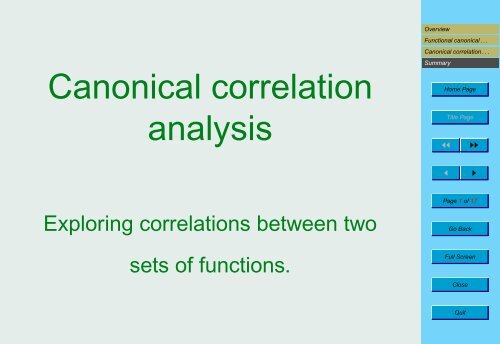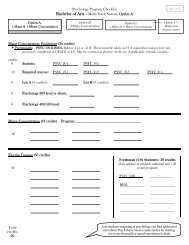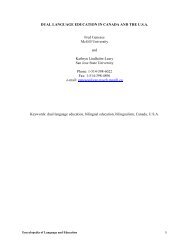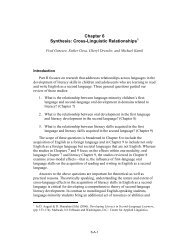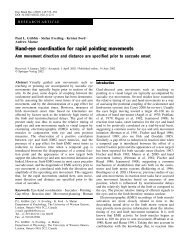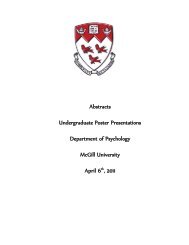Canonical correlation analysis
Canonical correlation analysis
Canonical correlation analysis
You also want an ePaper? Increase the reach of your titles
YUMPU automatically turns print PDFs into web optimized ePapers that Google loves.
<strong>Canonical</strong> <strong>correlation</strong><br />
<strong>analysis</strong><br />
Overview<br />
Functional canonical . . .<br />
<strong>Canonical</strong> <strong>correlation</strong> . . .<br />
Summary<br />
Home Page<br />
Title Page<br />
◭◭ ◮◮<br />
◭<br />
◮<br />
Exploring <strong>correlation</strong>s between two<br />
sets of functions.<br />
Page 1 of 17<br />
Go Back<br />
Full Screen<br />
Close<br />
Quit
1. Overview<br />
• Let the two sets of functions be x i (t) and y i (t), i =<br />
1, . . . , N.<br />
• The <strong>correlation</strong> surface r(s, t) offers <strong>correlation</strong>s for<br />
each pair of values [x i (s), y i (t)]. This may be more information<br />
than we can deal with.<br />
• We might prefer to only look at the dominant modes of<br />
<strong>correlation</strong> between two sets of functions.<br />
• We will explore the types of <strong>correlation</strong> between knee<br />
and hip angles for the gait data.<br />
Overview<br />
Functional canonical . . .<br />
<strong>Canonical</strong> <strong>correlation</strong> . . .<br />
Summary<br />
Home Page<br />
Title Page<br />
◭◭ ◮◮<br />
◭ ◮<br />
Page 2 of 17<br />
Go Back<br />
Full Screen<br />
Close<br />
Quit
Knee and hip angles for the gait data<br />
Overview<br />
Functional canonical . . .<br />
<strong>Canonical</strong> <strong>correlation</strong> . . .<br />
Summary<br />
Home Page<br />
Title Page<br />
◭◭<br />
◮◮<br />
◭<br />
◮<br />
Page 3 of 17<br />
Go Back<br />
Full Screen<br />
Close<br />
Quit
Knee and hip angles for the gait data<br />
Overview<br />
Functional canonical . . .<br />
<strong>Canonical</strong> <strong>correlation</strong> . . .<br />
Summary<br />
Home Page<br />
Title Page<br />
◭◭<br />
◮◮<br />
◭<br />
◮<br />
Page 4 of 17<br />
Go Back<br />
Full Screen<br />
Close<br />
Quit
Contour plot of <strong>correlation</strong>s between<br />
knee and hip angles<br />
Overview<br />
Functional canonical . . .<br />
<strong>Canonical</strong> <strong>correlation</strong> . . .<br />
Summary<br />
Home Page<br />
Title Page<br />
◭◭<br />
◮◮<br />
◭<br />
◮<br />
Page 5 of 17<br />
Go Back<br />
Full Screen<br />
Close<br />
Quit
Surface plot of <strong>correlation</strong>s between<br />
knee and hip angles<br />
Overview<br />
Functional canonical . . .<br />
<strong>Canonical</strong> <strong>correlation</strong> . . .<br />
Summary<br />
Home Page<br />
Title Page<br />
◭◭<br />
◮◮<br />
◭<br />
◮<br />
Page 6 of 17<br />
Go Back<br />
Full Screen<br />
Close<br />
Quit
2. Functional canonical <strong>correlation</strong><br />
<strong>analysis</strong> defined<br />
Probes for modes of <strong>correlation</strong><br />
Overview<br />
Functional canonical . . .<br />
<strong>Canonical</strong> <strong>correlation</strong> . . .<br />
Summary<br />
Home Page<br />
• Let the two sets of functions be x i (t) and y i (t), i =<br />
1, . . . , N.<br />
• Let a probe for the x functions be defined by<br />
∫<br />
ξ(t)x i (i) dt.<br />
Title Page<br />
◭◭ ◮◮<br />
◭ ◮<br />
Page 7 of 17<br />
• Let a probe for the y functions be defined by<br />
∫<br />
η(t)y i (i) dt.<br />
Go Back<br />
Full Screen<br />
Close<br />
• Given a pair of probe weighting functions (ξ, η), how<br />
strongly are the two sets of probe values correlated?<br />
Quit
The first canonical <strong>correlation</strong> ρ 1<br />
• We can re-phrase this question: What pair of probe<br />
weighting functions would give the highest possible <strong>correlation</strong><br />
between probe values?<br />
• The <strong>correlation</strong> that results is called the first canonical<br />
<strong>correlation</strong>, and indicated by ρ 1 .<br />
• Let the maximizing probe weighting functions be indicated<br />
by ξ 1 and η 1 . These are called the first pair of<br />
canonical weighting functions.<br />
• The probe scores<br />
∫<br />
∫<br />
f i1 = ξ 1 (t)x i (t) dt and g i1 =<br />
η 1 (t)y i (t) dt<br />
are called the first pair of canonical variables.<br />
Overview<br />
Functional canonical . . .<br />
<strong>Canonical</strong> <strong>correlation</strong> . . .<br />
Summary<br />
Home Page<br />
Title Page<br />
◭◭ ◮◮<br />
◭ ◮<br />
Page 8 of 17<br />
Go Back<br />
Full Screen<br />
Close<br />
Quit
Subsequent canonical <strong>correlation</strong>s ρ j<br />
Overview<br />
Functional canonical . . .<br />
<strong>Canonical</strong> <strong>correlation</strong> . . .<br />
Summary<br />
• We can repeat this process. Let a new pair of canonical<br />
weight functions ξ 2 and η 2 be defined, and let them<br />
satisfy the two restrictions<br />
∫<br />
∫<br />
ξ 1 (t)ξ 2 (t) dt = 0 and η 1 (t)η 2 (t) dt = 0.<br />
Home Page<br />
Title Page<br />
◭◭ ◮◮<br />
◭ ◮<br />
• We can again ask for the pair of ξ 2 and η 2 that maximize<br />
the <strong>correlation</strong> ρ 2 between the pairs of canonical variable<br />
values (f i2 , g i2 ) defined by these canonical weight<br />
functions.<br />
• And so on, until there are no more interesting canonical<br />
<strong>correlation</strong>s to be found.<br />
Page 9 of 17<br />
Go Back<br />
Full Screen<br />
Close<br />
Quit
Smoothing canonical weight functions.<br />
Overview<br />
Functional canonical . . .<br />
<strong>Canonical</strong> <strong>correlation</strong> . . .<br />
Summary<br />
Home Page<br />
• If you already know about the multivariate version of<br />
canonical <strong>correlation</strong>, you know that the method tends<br />
to produce a rather large number of large <strong>correlation</strong>s,<br />
and that these are often difficult to interpret.<br />
• There is the same problem in the functional environment.<br />
In fact, even worse. Subsequent canonical<br />
weight functions tend to emphasize higher and higher<br />
frequency modes of variation that are usually impossible<br />
to interpret, or else are not very interesting.<br />
Title Page<br />
◭◭ ◮◮<br />
◭ ◮<br />
Page 10 of 17<br />
Go Back<br />
Full Screen<br />
Close<br />
Quit
• The solution here as in principal components <strong>analysis</strong><br />
and smoothing, is to regularize the canonical weights.<br />
• We measure the roughness of each canonical weight<br />
function by the two penalties<br />
∫<br />
∫<br />
[Lξ j (t)] 2 dt and [Mη j (t)] 2 dt<br />
Overview<br />
Functional canonical . . .<br />
<strong>Canonical</strong> <strong>correlation</strong> . . .<br />
Summary<br />
Home Page<br />
Title Page<br />
◭◭ ◮◮<br />
◭ ◮<br />
where L and M are suitably chosen linear differential<br />
operators. L = M = D 2 will often be reasonable.<br />
• Each of these penalties is multiplied by a smoothing parameter<br />
λ.<br />
Page 11 of 17<br />
Go Back<br />
Full Screen<br />
Close<br />
Quit
3. <strong>Canonical</strong> <strong>correlation</strong> <strong>analysis</strong> for<br />
the gait data<br />
Overview<br />
Functional canonical . . .<br />
<strong>Canonical</strong> <strong>correlation</strong> . . .<br />
Summary<br />
Home Page<br />
• In order to explore the <strong>correlation</strong>s between knee and<br />
hip angles for the gait data, we first used D 2 to define<br />
both penalties on the roughness of each pair of weighting<br />
functions.<br />
• The weights placed on these two penalties were λ =<br />
0.001.<br />
• The first three canonical <strong>correlation</strong>s were 0.73, 0.58<br />
and 0.31. The next was 0.05.<br />
• It seemed that there were only three important modes<br />
of <strong>correlation</strong> between knee and hip angle.<br />
Title Page<br />
◭◭ ◮◮<br />
◭ ◮<br />
Page 12 of 17<br />
Go Back<br />
Full Screen<br />
Close<br />
Quit
The first two canonical weight<br />
functions for knee and hip angles using<br />
D 2 smoothing.<br />
Overview<br />
Functional canonical . . .<br />
<strong>Canonical</strong> <strong>correlation</strong> . . .<br />
Summary<br />
Home Page<br />
Title Page<br />
◭◭<br />
◮◮<br />
◭<br />
◮<br />
Page 13 of 17<br />
Go Back<br />
Full Screen<br />
Close<br />
Quit
Overview<br />
Functional canonical . . .<br />
<strong>Canonical</strong> <strong>correlation</strong> . . .<br />
Summary<br />
Home Page<br />
• But since the functions are essentially periodic, we decided<br />
that the harmonic acceleration operator would be<br />
a better choice of L and M.<br />
• Using λ = 10 −6 , we found the first four canonical <strong>correlation</strong>s<br />
to be 0.90, 0.81, 0.39 and 0.26.<br />
• This <strong>analysis</strong> highlighted only two dominant modes of<br />
variation.<br />
Title Page<br />
◭◭ ◮◮<br />
◭ ◮<br />
Page 14 of 17<br />
Go Back<br />
Full Screen<br />
Close<br />
Quit
The first two canonical weight<br />
functions for knee and hip angles using<br />
harmonic acceleration smoothing.<br />
Overview<br />
Functional canonical . . .<br />
<strong>Canonical</strong> <strong>correlation</strong> . . .<br />
Summary<br />
Home Page<br />
Title Page<br />
◭◭<br />
◮◮<br />
◭<br />
◮<br />
Page 15 of 17<br />
Go Back<br />
Full Screen<br />
Close<br />
Quit
Surface plot of <strong>correlation</strong>s between<br />
knee and hip angles<br />
Overview<br />
Functional canonical . . .<br />
<strong>Canonical</strong> <strong>correlation</strong> . . .<br />
Summary<br />
Home Page<br />
Title Page<br />
◭◭<br />
◮◮<br />
◭<br />
◮<br />
Page 16 of 17<br />
Go Back<br />
Full Screen<br />
Close<br />
Quit
Overview<br />
Functional canonical . . .<br />
<strong>Canonical</strong> <strong>correlation</strong> . . .<br />
Summary<br />
Home Page<br />
4. Summary<br />
• <strong>Canonical</strong> <strong>correlation</strong> allows us to simplify the study of<br />
the ways in which two sets of functions are correlated.<br />
• But we need to impose smoothness on the canonical<br />
weighting functions in order to keep the number of<br />
modes of variation with high <strong>correlation</strong>s small.<br />
Title Page<br />
◭◭ ◮◮<br />
◭ ◮<br />
Page 17 of 17<br />
Go Back<br />
Full Screen<br />
Close<br />
Quit


